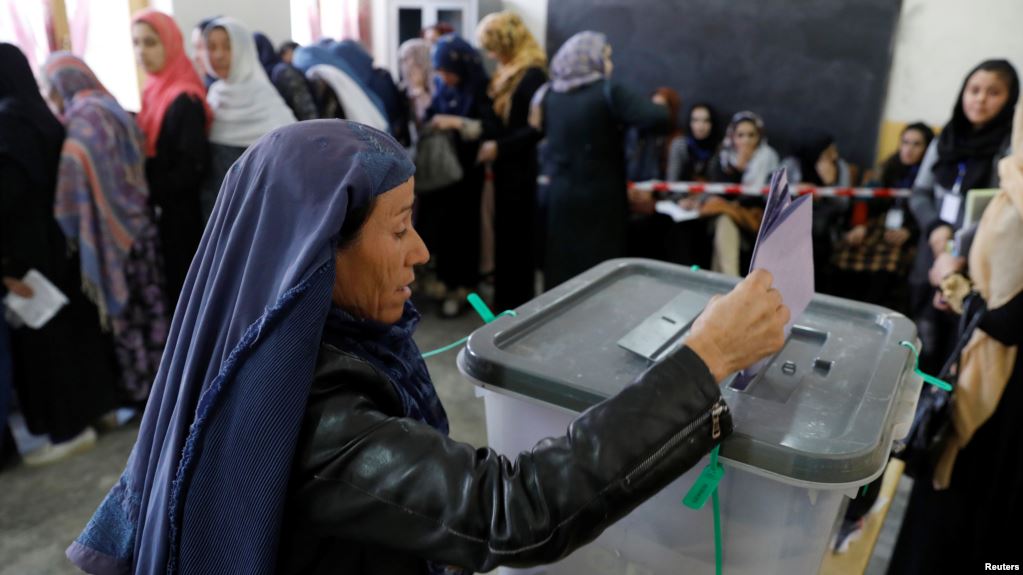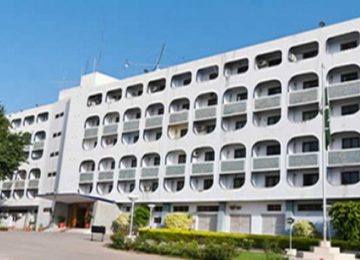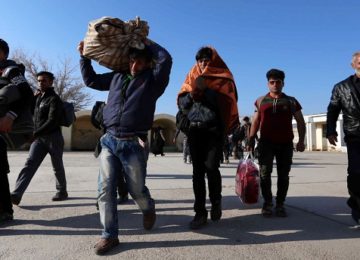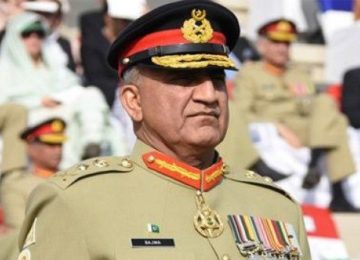The parliamentary election that was finally held after three and half year delay, was meant to end the extra-constitutionality of the legislature and boost the legitimacy of the state. New anti-fraud measures were put in place to ensure transparent elections, but they were poorly prepared and implemented. Now, after two days of voting, the IEC has to deal with at least three incongruous types of results, without having clearly determined which votes will be counted and which will be invalidated. AAN’s Ali Yawar Adili voted on the second day of the elections, in one of the centres that earlier did not open, and reports first-hand on the trials of the new systems and the chaos at his polling centre. He concludes that the IEC will have to now grapple with hard decisions on which ballots to count.
The night before the elections I stayed in the office, so I could start following the polling in the early morning without having to travel through security checkpoints. I live in the Hazara-dominated west of Kabul, which has been hit hard (see AAN’s background here and here) in recent years by bombings claimed by the Islamic State Khorasan Province (ISKP). I had registered in a polling centre at a mosque, Nabi Akram, near my rented apartment in the neighbourhood of Shahrak-e Omid Sabz, also known as Shahrak-e Haji Nabi, and I wanted to vote later in the day.
On the morning of the vote, I watched Independent Election Commission (IEC) chairperson Gula Jan Abdul Badi Sayyad and President Ashraf Ghani speak to the nation after voting in Amani High School. President Ghani congratulated the IEC members, saying that the Special Representative of the United Nations Secretary General had submitted a report to the UN Security Council that said that “technically, [this election] has been the most successfully prepared so far.” He also expressed appreciation for the Afghan security forces, especially the air force, for delivering election materials to all parts of Afghanistan – except Mandol district of Nuristan, he said, where the material had not yet arrived at the eve of the election, saying that “this morning, there will be attention for it, too.” (1)
In his speech, Ghani also mentioned that the people in Ghazni province were the only ones who would not have elections and that he had assigned Vice President Sarwar Danesh, Deputy Chief Executive Muhammad Khan and Independent Directorate of Local Governance head Matin Baig to “prepare the date for elections” in Ghazni. It was almost as if a new electoral commission had been set up especially for Ghazni. Why should the vice president set a date for the elections? I hoped that what he meant to say was that these officials would try to come up with a solution for Ghazni election issue(AAN reports here and here). He also said that elections would be soon held in Kandahar (AAN’s analysis here).
After watching the speeches, I called my wife to ask her if the polling centre where we had registered had opened on time. She told me my in-laws had just returned without voting because it had not opened yet. At around 10 a.m. I called my brother, who lives with my parents in the Shahrak-e Erfani neighbourhood, to remind him that the family should not go to vote in a group, but individually with enough time in between visits, so if there were an attack they would not all suffer at the same time. I considered Dasht-e Barchi, the Hazara-dominated area where they live, a double target: first, of the general violence aimed at disrupting the elections (and the Taleban’s threats of creating “severe obstacles” for the poll); and second, of possible ISKP attacks. The area was already hit on 22 April 2018 when the first phase of voter registration was ongoing (see AAN’s previous reporting here). My brother assured me that they were spacing their visits and that the first family member had just returned – also without voting because the polling centre had not yet opened.
For AAN’s election day reporting, I had been tasked to follow social media and the IEC and ECC websites. Starting at 8 a.m., an hour after the planned opening of the polling centres, the Internet was abuzz with complaints and criticisms by social media users saying that their polling centres had not opened on time or at all.
At 10 a.m., the IEC commissioners appeared in their first press conference of the day. IEC chairman Sayyad apologised to the people for the late opening of polling centres, saying that it was because “Some teachers were working [with us] in this process who, unfortunately, due to security problems, could not report to some polling stations on time.” He also said that they had instructed all employees in Kabul and the provinces to compensate for the wasted time.
Social media continued to be replete with complaints, which also included some funny and interesting comments. For instance, Muhammad Amin Ahmadi, who is the president of private university Ibni-e Sina, wrote at 11:55 a.m.: “Poor management.. apparently, only President Ghani and his entourage were able to vote without any trouble.” That rang true, as Tolo news tweeted that even Vice President Danesh, whose polling centre was different from that of the president, had waited for “45 minutes” for the opening of his polling centre in the Baqer-ul Olom mosque.
Dawran Ali Hakimi wrote on his Facebook page: “We, the citizens of the country of Ghazni, are strongly concerned about widespread fraud in the parliamentary elections in our friendly and neighbouring country of Afghanistan.” This was a satirical reference to the fact that Ghazni, my own province of birth, was not holding elections and people from that province felt as if they were not part of this country.
The IEC started its second press conference of the day at 12:26 p.m., where the IEC chairman read their decision number 89-1397 in which the IEC ruled that:
In polling stations where employees arrived late or election materials arrived late, the voting shall be extended up to 8 p.m. [the text of the decision which was posted on the IEC’s page said 6 p.m.] and the voting should continue until [all] the voters who are in queue by 6 p.m. [have voted]. If the polling centres are not opened until 1 p.m., the elections in [those polling centres] will be held tomorrow.
This was like an extension of the election for another day. Earlier I had wondered whether the 3,644 voters who had registered in my polling centre would be disenfranchised. (2) Now I was struggling to understand what the extension meant and whether it was in accordance with the electoral law. I still hoped that my polling centre would open by 1 p.m. but when I called my wife, she said it had not. So I was not able to exercise my right to vote and fulfil my civil duty on the first day of the elections.
At the end of the first day of the poll, IEC chairman Abdul Badi Sayyad provided the following details (see also AAN’s previous reporting here):
- More than three million voters cast ballots so far
- Highest voter turnout recorded in four provinces: Kabul, Herat, Daikundi and Nangarhar
- Lowest turnout recorded in Urozgan
- Highest female turnout in Jawzjan (53%)
- Lowest female turnout in Zabul (9%)
- 401 out of the more than 4,900 polling centres that had planned to open across the country could not open due to technical problems or security threats (45 of them were in Kabul).
- Turnout figures from 253 polling centres had not arrived yet
He reiterated that the polling centres that did not open on the first day of the elections would be opened the following day. (According to his press conference before noon on the following day, in the end more than 200 of these 401 centres that had not opened on the first day of the election, had managed to open on the second day.
Second day: another voting day
I woke up late the next morning and decided to go to the polling centre without having breakfast. But when I checked Facebook I saw that voters at the centre found that it had not opened yet (the IEC had not specified what time the poll would open on the second day; on the first day, it was supposed to open at 7 am). So I had breakfast after all. When I finally arrived at the polling centre, it was 9:30 a.m. There was a long queue of voters waiting for the balloting to start. Agents and observers were allowed to enter first and because I had an observer card issued by the IEC, I went in. There was a high level of disorder inside the polling centre. There was no queue control and people were already crowding inside the hall.
Voter list problem
The polling centre had been allocated four male polling stations (there was a separate hall with a separate entrance for the female polling stations). The polling station officials had handwritten the first letters of the names of the voters that were supposed to vote at each polling station and had fastened these papers on the walls, pillars and voting booths, to help voters find where they had to go. However, there was still confusion. For instance, the letter with which my name starts was written on two polling stations. I went to the first polling station which had the first letter of my name, but when the voter identification officer checked the whole list, my name was not there. I then went to the other polling station which also had the first letter of my name. The voter identification officer told me that only three names that started with this letter were on the list. Thank God, one of them was mine.
(Later, I saw a candidate who was standing in the wrong line, because his name started with a letter that was on the signposts of two polling stations. I told him that his name would probably be on the list in another polling station. He left the line and went to the polling station, where he did indeed find his name.)
From there, I found that the procedures were followed smoothly. The identification officer checked my tazkera,and the registration sticker fixed on the back, with a flashlight to ensure that it was not marked with a tick (which would indicate that I had already voted). He then drew a tick, which I couldn’t see, with an invisible-ink marker. The polling station chairperson showed me how the tick could only be seen with the flashlight. Then the biometric registration officer captured my fingerprints (left and right index finger) and photos (my face, my tazkera, and my voter registration sticker). (3)
Then I went to the ballot issuer who was also in charge of the small printer that was wirelessly connected to the data capturing device. He took the sticker with the polling centre, date, time and a unique number written on it, as well as an encrypted image, stuck it on the ballot and gave it to me. (On the eve of the elections, AAN raised concern that the biometric machines could compromise the secrecy of the vote, which is an international standard and guaranteed by the constitution. I could see and note down the data on the sticker that was attached to my ballot, and would now easily be able to find my ballot if the box were opened for me.) Then I went behind one of the four voting booths to find my favourite candidate. The ballot paper was large and unwieldy – 16 pages with three columns each. When I had selected my candidates I went to cast my vote in the box. The ballot box controller cleaned my right index finger with a handkerchief and asked me to immerse it into the ink until the first fold, so I would not be able to vote again.
When I was finished voting, I visited the other polling stations to observe. I noticed another problem with the lists: there were handwritten lists at each polling station. The identification officers told me that this was for voters whose names were not on the official voter list. One officer told me that “We cannot disenfranchise the people. They have come, so they should be allowed to vote.” The chairperson of another polling station said that this was in accordance with an order from the manager of the polling centre.
In the afternoon, I discussed the election with a visiting Australian expert who said that this could happen in Australia too, that voters might not be on the voter list, but that they have a “safety net.” Electoral officials allow these voters to cast a “provisional vote” in a separate envelope. (4) The problem here however is that because the IEC had not properly anticipated the problems before the elections – even though it was likely that they would occur – a hasty and incomplete decision was made at midday on the first day of the elections (see also AAN’s reporting here and here).
Biometric machines: a perceived panacea turning into a headache
On the eve of the elections, AAN released a report describing how the IEC had made a last-minute decision under heavy political pressure to use biometric machines as an additional anti-fraud measure. We had laid out the concerns, including over what would happen if the machines did not work or were not operated properly. So I was particularly curious to see how the machines would function.
In my polling centre, I found that one of the polling stations was conducting the vote without capturing the biometric data of the voters. The polling station officials said their biometric device was not working. (My wife voted in the female section of the same polling centre later in the afternoon. She said she had voted without biometric data capturing, as the polling station officials told her the printer of the device had run out of paper.)
This did not surprise me. The IEC’s contingency solution for faulty or missing devices had simply been to use the device from another station. As we reported here the IEC had not anticipated what should be done if no functioning machine could be found, or what the IEC would do with the voting data if IEC staff did not properly use the machines.
As a result the IEC had to scramble to update its procedures during the first day of the elections when it realised the devices were not working everywhere. In the end they decided that, if all else failed, people would be allowed to vote without biometric verification. (5)
On the second day, however, many polling agents seemed unaware of the IEC’s decision and were objecting to the vote proceeding without biometric verification. Some were loudly saying that specific ballot box would be quarantined.
Amin Ahmadi, president of Ibn Sina University, quoted above, voted at that same polling station that was not using biometric machine. He wrote on his Facebook page that when he raised this concern, the polling station chairperson had assured him his vote would not be invalidated. (6) Many voters and candidate might still be wondering what will happen to the polling stations that did not capture the biometric data of the voters. The political parties that had been the main force pushing for biometric system issued an accusatory statement on 22 October2018, saying that “on 20 and 21 October, the biometric system [for capturing the data] of voters was not used in the majority of the polling centres, intentionally, in order to pave the way for fraud. Therefore, the political parties of Afghanistan consider the election results from polling centres where voting was not conducted with the biometric method as invalid.” (statement here and media report here)
There was also a concern that the voting pattern on the first day might influence the voters’ decision on the second day. For instance, I saw two advisers to Vice-President Danesh visit a polling centre to check how it was going. One of them said they had been awake late the night before to make sure the results from the polling centres that had opened in west of Kabul – a densely-populated area that seemed most affected by polling centres not opening– were not made public.
Disorder at the polling stations
Because I voted on the second day of the elections, I had anticipated better order at the polling stations, as I thought the IEC would have learned from the previous day. Moreover because fewer polling centres would open, it should have been easier to manage. However, this was not the case. Political party and candidate agents, and people identifying themselves as members of the board of trustees of the mosque, were standing at the gate of the mosque, trying to control entry into the polling stations. When I asked one agent whether he was trying to tell people whom to vote for, he said he was just helping “so that all of them can vote.”
One reason for the disorder probably emanated from changes in the role of the polling station officials when thee IEC introduced the biometric devices (see the annex to this dispatch for an English translation of the new procedure). Previously, each polling station had a queue controller, but because of the biometric voter verification, the queue controller of each polling station was made to operate the biometric machines. The chairperson of the polling station was instead supposed to also control the queues. This led to a lack of control over the crowds.
Throng of agents and observers
There were many agents and observers in the polling stations. Some were actively observing the vote from behind the ribbon at each polling station, noting down the code and name of the polling centre and the number of the polling station. Others were lying down or sitting on the carpet behind another ribbon that separated the four polling stations from the rest of the space inside the hall of the mosque, and simply resting or chatting.
Agents and observers as well as voters could file complaints with a female representative of the Electoral Complaints Commission who was sitting outside between the buildings that were accommodating the male and female stations. But only those who were curious could know, as there was no sign showing that there was an ECC representative stationed somewhere inside the compound of the mosque. I asked a candidate agent who did not know about the ECC representative. Another agent, however, knew that an ECC representative was based outside the halls and that they could file their complaints there.
A restriction was imposed on agents and observers this time. The IEC had tied each agent and observer to a specific polling centre, which may well have limited the ability of the observer organisations to effectively cover all polling centres, as they could not move around. For instance, it might have been difficult for an observer organisation to deploy 555 people to all 555 polling centres in Kabul.
Conclusion: new systems and new problems
This year’s parliamentary election saw two major new anti-fraud systems: voter lists for each polling station and the use of biometric voter verification. Using only the new voter lists would have already introduced problems on their own. But to top that off, the biometric machines were introduced at the last minute and the IEC was not ready. Polling staff had not received proper training, or training at all. The devices had not been field-tested. The procedures and contingency plans were incomplete. It is unlikely the implications of the possible fraud triggers have been thought through.
Now, after the second day of voting – and with more days to come, in Kandahar (which the IEC has scheduled for coming Saturday, 27 October) and Ghazni (not decided yet) – the IEC will have to deal with at least three types of results being retrieved from the polling centres and provinces: a) from polling stations that used both the voter lists and the biometric verification, b) from polling stations that used only the voter lists, without capturing the biometric verification data, and c) from polling stations that used neither of the two systems and made new on-the-spot, handwritten voter lists.
Before the election, the IEC said that votes cast without the capture of biometric data would not be counted. So far, it is unclear how many polling stations failed to use the biometric system or had to conduct the poll without voter lists. Or how the IEC will deal with it.
Edited by Martine van Bijlert
(1) This surprised me. When looking at the voter lists published on the IEC’s website, earlier, I had noticed there had been no voter registration in Mandol district. So I wondered what the president meant, saying there would be attention for that district. There were more districts that had not registered any voters at all, for instance Shahid Hassas and Khas Urozgan un Uruzgan (see here). So I found little meaning in the president’s congratulatory statement that materials had been delivered to all parts of the country.
(2) My urban district, nahiya six, had a total of 27 polling centres which had registered 72,155 voters. Kabul province comprises 14 rural districts and 22 urban districts with a total of 555 polling centres that had registered voters (see here). On 29 November 2017, after the general polling centre assessment, the IEC had approved 553 polling centres, decreased from 557 (see here), but on the final voter list there were 555 centres. It is not clear how they added two more polling centres. In total 1,632,197 voters were registered in Kabul; 1,041,185 male and 522,214 female, as well as 68,039 Kuchis and 759 Hindu/Sikh.
The 14 rural districts had a total 181 polling centres with 473,089 voters registered. The 22 urban districts had 374 polling centres with registered 1,159,108 voters. The urban district nahiya 21, for some reason, was not on the IEC’s voter list for Kabul. It is not clear whether it did not register any voters or was just missing from the list).
(3) According to the IEC’s recent annex to the voting and counting procedures (see the annex of this dispatch the facial picture should be taken in such a way that it is clear the picture was taken in a polling station during the vote. I was standing in front of a ballot box, but am not sure it showed in the picture.
(4) A handbook on the Australian Electoral Commission’s website explains the following procedures for the provisional vote (see here):
Provisional voting – eligibility
An elector may be issued with a provisional vote if:
- their name cannot be found on the certified list of voters for the division (the Act, s.235(1)(a)), or
- their name is on the certified list of voters but their address does not appear on the list (these may be silent electors who for reasons of personal or family safety do not have their address shown) (the Act, s.235(1)(b)), or
- the officer in charge has asked the person one or more questions under subsection 229(4) about matters shown on the certified list of voters for a particular person to establish whether the person is that particular person and one of the following applies:
- their answers do not accord with the relevant information shown for that particular person on the list (the Act, s.235(1)(c)(i)),
- their answers accord with the relevant information shown for that particular person on the list but the officer is not satisfied that the person is that particular person (the Act, s.235(1)(c)(ii)),
- they refused to answer fully (the Act, s.235(1)(c)(iii)), or
- their name has been marked on the certified list of voters as having already voted at the polling place (and the voter claims not to have voted before) (the Act, s.235(1)(d)), or
- the person is provisionally enrolled as a new citizen (the Act, s.235(1)(e).
Provisional voting – completion and return
The Act, s.235
The following procedures apply to provisional voting:
- the issuing officer must show the voter a written statement (either as a separate card or on the back of the declaration envelope) explaining provisional voting and the procedures followed.
- the provisional voter must answer in writing the questions put to any ordinary voter (with the exception that an elector with their address suppressed from the electoral roll is not required to publicly disclose their address).
- the provisional voter must sign a declaration on an envelope provided for the purpose, in the presence of the issuing officer, who must then sign as witness to the declaration and add the date.
- on receipt of a ballot paper, the provisional voter casts their vote in the ordinary manner.
- the provisional voter returns the folded ballot paper to the polling officer, who then places it in the signed and witnessed declaration envelope, seals it and puts it in the ballot box for later dispatch to the DRO.
(5) According to decision No 89-1397, which was read at a noon press conference on the first day of the election:
In polling stations where the biometric machines failed to work or have not been delivered, technical options [not clear what it means] should be used to solve the problem. If the problem remains [unresolved], contingency machines or the machines belonging to closed polling centres should be used. If the problem still remains [unresolved], the voting should continue based on the voter list and people should be allowed to vote. At the end, the polling station chairperson and monitors should write the issue in the journal in detail and get the approval of the agents and observers.
(6) Ahmadi also added that after he voted he came across Sayyed Khodad Mosawi (perhaps, the CEO of MyICT, the local partner of Dermalog, the implementer of the biometric contract) whom he described as a software engineer he had met at an academic event earlier. According to Ahmadi, when he told Mosawi that his polling station did not have functioning biometrics, Mosawi went inside and found out that the device had simply not been charged properly.
By Special Arrangement with AAN. Original link.
Disclaimer: Views expressed on this blog are not necessarily endorsed or supported by the Center for Research and Security Studies, Islamabad.








